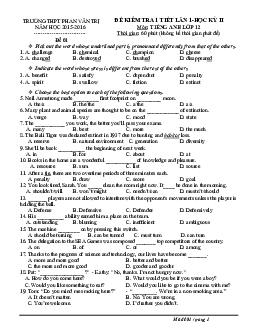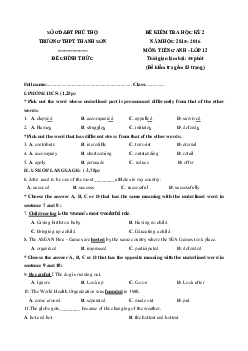





Preview text:
TRUNG TÂM GIÁO DỤC THƯỜNG XUYÊN ĐỀ THI HỌC KỲ 2 TỪ LIÊM NĂM HỌC 2015 - 2016
MÔN: TIẾNG ANH - LỚP 12 Thời gian: 45 phút
I. Multiple choice question ( 7.5 marks)
Choose the word whose underlined part is pronounced differently from that of the rest. 1. A. measure B. television C. mistake D. decision
2. A. quiet B. activity C. title D. smile 3. A. butter B. put C. sugar D. push
Circle the word whose stress is placed differently from that of the rest. 4. A. imagine B. especial C. unnoticed D. character 5. A. habitat B. endanger C. commercial D. destruction
Choose the suitable word or phrase to complete these sentences.
6. In the past people believed that women’s ________ roles were as mothers and wives. A. nature
B. natural C. naturism D. naturalist
7. The more goods we export, the ________ jobs we can create in our country. A. more B. many C. much D. good
8. If you take a good book on your hand, you will find it hard __________. A. to pick it up
B. to put it down C. to read it D. to enjoy it
9. The acronym of WHO stands for ________. A. World Healthy Organization B. World Health Organization C. World Health Organizing
D. World Healthful Organization
10. Please _________ this form and post it. A. turn on
B. fill in C. look up D. give up
11. -“What does this word mean?” -“Why don’t you _____in your dictionary?”
A. look it into B. look it up C. look it for D. look it after
12. ASEAN was founded on August 8, 1967 with five _________: Thailand, Indonesia, Malaysia,
Singapore, and the Philippines. A. members B. competitors C. leaders D. statesmen
13. Many species have become extinct each year before biologists can identify them.
(Unit 10 / tuần 21/ mức 2) A. destroy B. drain C. endanger D. discover
14. ________ is a sport in which two or more people perform complicated and carefully planned movements in water to music. A. Rowing B. Windsurfing
C. Diving D. Synchronized swimming
15. . Remember to __________ your shoes when you come to a Japanese house. A. take after B. put in C. take off D. put on
16. No one in the team can play better than John.
A. John plays well but the others play better.
B. John as well as other players of the team plays very well.
C. Everyone in the team, but John, plays very well.
D. John is the best player of the team.
17. Earning money has always been the thing that pleases him most. _______ he becomes,…… he is.
A. The more rich / the more happy B. The richest / the happiest C. The richer / the happier
D. Richer and richer / happier and happier
18. The _______ is increasing faster and faster. A. Gross Domestic Product B. Gross Domestic Production C. Growth Domestic Product
D. General Domestic Production
19. _________ he had a suggestion, he didn’t raise his hand. A. because B. Although C. However D. Therefore
20. The bomb exploded in the garage; fortunately no one hurt. A. put on B. went off C. got out D. kept up
Fill each of the numbered blanks in the passage below with suitable words.
Singapore has a highly developed market-based economy (21) _______ historically revolves around
extended trade. Along with Hong Kong, South Korea and Taiwan Singapore is one (22)_______ the Four
Asian Tigers. The economy depends heavily on export, refining, imported goods, especially in manufacturing.
Manufacturing constituted twenty six (23) ________ of Singapore’s GDP in 2005. The manufacturing
industry is well –diversified into electronic petroleum refining chemicals, (24) _______ engineering and
biomedical sciences manufacturing. In 2006, Singapore produced about 10 percent of the world foundry water
output. Singapore’s the busiest port in the world in terms of tonnage shipped. Singapore is The world’s fourth
largest foreign exchange trading centre after London, New York City (25) _______ Tokyo. 21. A. who B. whom C. why D. which 22. A. of B. in C. for D. at 23. A. percentage B. persuasion C. perception D. percent 24. A. mechanical B. mechanically C. methane {CH4} D. Mechanic 25. A. and B. but C. or D. so
Choose the correct answer to each of the questions.
Until the 19th century, the denial of equal rights to women met with only occasional protest and drew
little attention from most people. Because most women lacked the educational and economic resources
that would enable them to challenge the prevailing social order, women generally accepted their
inferior status as their only option. At this time, women shared these disadvantages with the majority of
working class men, as many social, economic, and political rights were restricted to the wealthy elite
[phần tử ưu tú]. In the 19th century, as governments in Europe and North America began to draft new
laws guaranteeing equality among men, significant numbers of women – and some men – began to
demand that women be accorded equal rights as well.
At the same time, the Industrial Revolution in Europe and North America further divided the
roles of men and women. Before the Industrial Revolution most people worked in farming or crafts-
making, both of which took place in or near the home. Men and women usually divided the numerous
tasks among themselves and their children. Industrialization led male workers to seek employment
outside of the home in factories and other large-scale [extensivve]enterprises. The growing split
between home and work reinforced the idea that women’s “rightful place” was in the home, while men
belonged in the public world of employment and politics.
Organized efforts by women to achieve greater rights occurred in two major waves. The first
wave began around the mid-19th century, when women in the United States and elsewhere campaigned
to gain suffrage [ right to vote in political elections]– that is, the right to vote. This wave lasted until the
1920s, when several countries granted women suffrage.
26. Why did the denial of equal rights to women draw little attention from the society until the 19th century?
A. They could not challenge the prevailing social order.
B. They did not have any other option.
C. Most women lacked the educational and economic resources. D. All are correct.
27. Until the 19th century, what was the status of the working class men in the society?
A. They had the same rights as women. B. They had no right at all.
C. They did not have much power compared to the wealthy people.
D. They had much power in the society.
28. When did the women’s movement start in Western countries? A. in the 18th century B. in the late 18th century C. in the 19th century D. in the early 20th century
29. What did the effect of the Industrial Revolution in Europe and North America bring about?
A. Male workers tried to seek employment outside of the home.
B. It did not bring the equality to women.
C. Well-educated, upper-class men controlled most positions of employment and power in society. D. All are correct.
30. What was the aim of the women’s movement in the United States in the 1920s?
A. to gain the right to have much power in the society B. to gain the right to vote
C. to gain the right to go to work in the factory
D. to have the complete equality to men
II. Rewrite the sentences beginning with the words given. (2.5 marks)
31. They are producing motorbikes in Vietnam. ->Motorbikes are
..........................................................................................................................................
32. The boy was rushed to hospital. His arm was broken.
-> The boy whose …………………………………………………………………………..……………
33. We are going to Hanoi. We will come to see you.
- > As soon as ………..………………………………………………………………………………
34. I wasn’t there yesterday, so I didn’t know who he was. - >If I
............................................................................................................................................................
35. He will have a birthday party soon. He will invite his friends.
-> …………………………………….before…………………………………………………………… ANSWER KEYS
I. Multiple choice question (7.5 marks) 1 C 6 B 11 B 16 D 21 D 26 D 2 B 7 A 12 A 17 C 22 A 27 D 3 A 8 B 13 D 18 A 23 D 28 C 4 D 9 B 14 D 19 B 24 A 29 D 5 A 10 B 15 C 20 B 25 A 30 B
II. Rewrite the sentences beginning with the words given. (2.5 marks)
31. Motorbikes are being produced in Vietnam
32. The boy whose arm was broken was rushed to hospital
33. We are going to Hanoi. We will come to see you.
- > As soon as we go to Hanoi, we will come to see you.
34. If I had been there yesterday, I would have known who he was
35. He will have a birthday party soon. He will invite his friends.
- > He will invite his friends before he has a birthday party.



